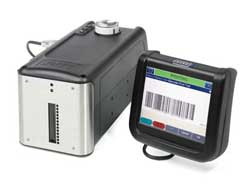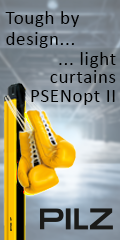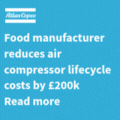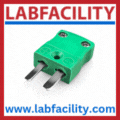
Posted to News on 16th Oct 2008, 19:06
Linx IJ350 LCM ink jet coder features self-cleaning function
Linx Printing Technologies is underlining its commitment to large character marking (LCM) with the launch of the Linx IJ350, a fully featured self-cleaning LCM coder. The new model is being exhibited at PPMA 2008 alongside the Linx IJ600 single-head high-definition coder and one of Linx's recently launched pigmented inks for LCM applications.

Suitable for outer case or secondary packaging, the Linx IJ350 offers ease of maintenance, consistently high print quality, a simple user interface and flexible and easy installation. Highlights include a fully enclosed, self-cleaning printhead with patented micro-purge system, a compact, detachable display unit featuring at-a-glance status indication and an intuitive, icon-based touchscreen.
Designed to meet the requirements of customers who need clear, legible and accurate coding of secondary packaging, the Linx IJ350 is a fully featured LCM coder. According to Linx, existing products on the market are not always necessary or cost-effective and require significant investments in time and effort to keep them running to the required standard.
Reduced downtime
Extensive customer research revealed the key drivers behind LCM purchasing decisions and underpinned the development of the Linx IJ350. Regular cleaning of the printhead was cited as a priority to maintain the high print quality demanded by many retailers, even for simple barcoded applications, and customers also want to avoid the hassle of shutting the printer down - with the associated costs of downtime - in order to clean the printhead manually. Installation was another concern, with customers keen for the display screen to be located where it is most convenient for operators, rather than a fixed position that might require inefficient movement to reach it. Also key was day-to-day ease of operation: user interfaces should be simple, intuitive and icon-based to ensure that little or no training is required before use.
All of these factors are built into the Linx IJ350. The coder's self-cleaning micro-purge system uses a small film of ink on the printhead to collect dirt and debris prior to printing. This is blasted with air to clean the ink from the printing plate; the ink is collected and recirculated, passing through a high-performance filter to ensure no dirt enters the printing system. This recycling also reduces the overall cost of ownership and eliminates the need to dispose of waste ink.
Compact and portable, the coder can be installed wherever it is required, and moved easily between lines. A long cable ensures that the display can be mounted up to 3m from the printhead for optimum positioning, while a single display can be used for multiple printers. Flexibility in installation also comes from the capability to network up to four printers together, controlling them all from one 'master' printer or via network control software.
The icon-based touchscreen is simple to use even with minimal or no training: common tasks are only one touch away, and the majority of other functions can be accessed within two touches. The screen is WYSIWYG (what you see is what you get) for ease of message selection, and has a highly visual status bar, using a 'traffic light' colour-coded system, for at-a-glance updates. A range of software options is also available, including Claricom Package Coding Management (PCM) software, Windows printer drivers and compatibility with a range of label creation packages. The Linx IJ350 prints characters up to 50mm in height. For larger printing applications, Linx also offers the Linx IJ370, which is capable of printing 70mm.
High-quality and cost-effective
Dr Paul Doody, Product Manager at Linx, comments: "The growing worldwide need for legible and clear coding on secondary packaging such as outer cases is being driven by increasing requirements for traceability and brand identification, and large character marking is emerging as one of the most cost-effective and versatile means of achieving this accurately and efficiently. The Linx IJ350 has been specifically designed to meet customer needs for high-quality LCM coding, and customers have responded extremely positively to its features. The exceptional performance, flexibility and ease of use of the Linx IJ350 re-emphasises our commitment to providing high-quality and cost-effective coding solutions along the whole packaging line."
Linx's capabilities in LCM are also demonstrated at the PPMA show with the Linx IJ600, which offers a self-cleaning system allowing operation in even harsh industrial environments thanks to a rugged, dust-proof IP65 enclosure. Designed to provide superb print quality and superior uptime, the coder also features a shock-resistant and retractable printhead.
With an intuitive user interface for simple start-up and message selection, the printer is easy to maintain and operate. The Linx IJ600 has independent printhead control, and many software configurations, conduit lengths, printhead heights and orientation combinations are possible, resulting in a printer suitable for almost any outer case coding application, including pre-printed sack and box varieties. It provides excellent print quality graphics, text and barcodes on almost all porous surfaces. Most importantly, the barcode quality meets supermarket and supply chain industry requirements.
Using an oil-based ink, the coder can print large and small characters, logos and barcodes up to 70mm high onto secondary packaging made from substrates such as multi-wall paper sacks and cardboard boxes. The printhead is also self-cleaning and can print in any orientation up to 8m away from the control unit. The one-touch start/stop operation allows quick and easy start-ups. Additionally, the combination of the IJ600's IP65-rated stainless steel enclosure and the pressure and temperature control at the point of print enables the printer to operate in tough production environments, such as flour mills or other bulk food facilities.
Dr Paul Doody comments: "The IJ600 offers a truly versatile alternative to existing outer case coding methods, offering exceptional performance, quality and user convenience in harsh and demanding applications."
New inks
Linx has recently expanded its range of inks for the Linx IJ600, offering customers the choice of several pigmented inks to suit a wide variety of end-user LCM needs. The range is represented at the PPMA Show by Linx Red ink LC8130, which joins the existing Link Black ink LC8120 and fellow newcomers Linx Green ink LC8140 and Linx Blue ink LC8150. All four are specially formulated, micropigmented inks, designed for use with the Linx IJ600. These inks are suitable for coding onto a wide range of porous substrates where image quality and code legibility are of prime importance. Suitable for use with paper, card, wood and ceramics, these inks give permanent legible codes for a variety of end uses - such as product identification, corporate branding, contact information or ingredients list.
Additional colours allow customers to choose the most suitable option for specific applications. Linx Green ink LC8140, for example, is useful for printing large-character environmental or recycling messages. Typical uses for Red ink 8130 and Blue ink LC8150 might include hazard symbols or identification of chilled foods in supply chains.
Linx inks for LCM are oil-based and dry rapidly on suitable substrates. They have a low odour and low volatility, making them suitable for case-coding in food applications. The micropigments in the inks ensure the codes do not bleed or rub off porous substrates. In addition, the printed message resists most organic solvents and can withstand exposure to the elements in most environments for more than a year, making them suitable for outdoor applications such as wood used as a building material.
Dr Paul Doody comments: "The high quality of Linx's LCM inks allows manufacturers enormous flexibility in brand presentation and case design, so that they can use a single outer-case solution without sacrificing the impact, brand identification and aesthetic appeal demanded by marketing departments, supermarkets and customers. Used in conjunction with Linx's high definition LCM printer, the Linx IJ600, these inks are suitable for demanding applications. This expansion of our range reflects Linx's commitment to our customers by offering a wide choice of ink options to suit their particular needs."






